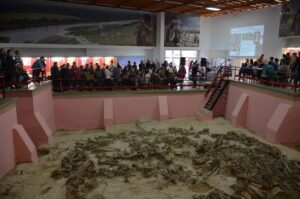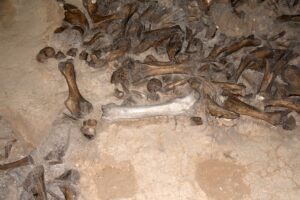
It was a remarkable discovery. In March of 2020, the journal Antiquity published a research paper detailing the analysis by a team from the University of Exeter, University of Cambridge, Kostenki State Museum Preserve, University of Colorado Boulder and the University of Southampton, of what has been referred to as a mammoth-bone circle located at the village of Kostenki, 500 km south of Moscow in the Russian Plains. Dated to 20,000 BP, it is now considered the oldest known circular structure of mostly mammoth bones like this built by humans in present-day Ukraine and the west Russian Plain. So far, 70 such structures have been discovered in the region. While most of the bones at the Kostenki site consisted of a total of 51 mammoth lower jaws and 64 mammoth skulls used to construct the 30ft by 30ft wall structure, with other mammoth bones scattered within its interior, site investigators also found bones of reindeer, horse, bear, wolf, red fox and arctic fox. They also recovered more than 300 stone and flint chips—debris created from knapping stone nodules into sharp tools that could be used for tasks like butchering animals and scraping hides.
__________________________

The Kostenki mammoth-bone circle remains as can be seen within the museum. Владислав Тищенко, CC BY-SA 4.0, Wikimedia Commons
__________________________

Mammoth bones at Kostenki (detail). evatutin, CC BY-SA 3.0, Wikimedia Commons
__________________________
Why were these structures built?
Archaeologists have advanced several possible explanations, ranging from habitation to places used for community activity and ritual/religious practices. None of them offer a slam-dunk interpretation of their purpose.
Enter here John Gleissner, a retired attorney, writer, history buff, and deer/meat hunter for 40 years, who undertook an extensive study of the available evidence for mammoth hunting by prehistoric humans. His conclusory hypothesis:
The mammoth-bone circles were actually smokehouses.
“Hunting experience and meat processing of wild game allowed me to see the practical aspects missed by a large number of archaeologists,” says Gleissner. “Many archaeologists failed to recognize the practical aspects of meat science, carcass transportation, and the accumulation of so much bone and so many tusks in these isolated locations”. Gleissner continues, “The hunters only had two basic options to bring the raw meat directly to a form for immediate consumption or, at their discretion, stored for future consumption. One of those options was dried, tough, stringy fully dried meat strips, and the other was to smoke larger pieces and retain some moisture.”
________________________
Advertisement

TAKE A GLORIOUSLY SCENIC WALKING JOURNEY ON ANCIENT ETRUSCAN PATHS FOR THE EXPERIENCE OF A LIFETIME!
________________________
According to his suggestion, which he calls the Smokehouse Hypothesis, the Paleolithic hunters killed mammoths in the beds of the rivers, floated the carcasses down to a location near their settlements located on promontories above the rivers, butchered the mammoths, and then took the meat to smokehouses they constructed on promontories above the rivers to smoke, cure and store. Each mammoth could produce two to three metric tons of raw meat, which had to be processed at one time.
“River transport of the carcasses is the only way that many skulls, tusks, bones, and meat could be brought to a single location,” Gleissner maintains.
Moreover, if Gleissner’s hypothesis can be supported through further study, the Paleolithic hunters may have used what could be one of the earliest forms of cold-smoking—the food preservation technique that involves exposing food to smoke at a low temperature without cooking it.
Archaeologist Dr. Ran Barkai of Tel Aviv University encouraged and supported, with literature, Mr. Gleissner’s research. “Archaeologists found many artifacts consistent with smokehouses in the smokehouse floors,” continued Gleissner, “and we are indebted to them for all their research.”
“Smokehouses included mammoth-bone circles, large oval smokehouses, and long smokehouses,” he added. “The most telling clues are nine (9) hearths arranged in a line around a structure matching that arrangement, with the line along a precise NW/SE axis. Back in Dolni-Vestonice (an Upper Paleolithic archaeological site near the village of Dolní Věstonice in the South Moravian Region of the Czech Republic), [for example] some of the floors of the smokehouses had 80 to 100 cm of ash forming the floors”.
Gleissner emphasizes the importance of terrain, hunting site advantages, and that all the mammoth-bone circle settlements were directly above navigable rivers. In a more detailed research manuscript, he details the bulk work efficient “production line” from first observing mammoths to consumption of smoked meat. He has submitted the manuscript to a number of peer-reviewed academic journals. He anticipates publication this year.
Meanwhile, new discoveries and research will likely continue to produce new questions and answers revolving around the mysterious mammoth-bone circles of Ice Age hunters marking the landscape of present-day eastern Europe and Russia. One unanswered question is: where did the hunters spend the winters? Gleissner doubts they spent it on the tops of ridges and hills exposed to the winds of the Russian Plain.
Cover Image, Top Left: Mammoth, AI-generated. JuliusH, Pixabay https://pixabay.com/users/juliush-3921568/
_________________________
Advertisement

EXPLORE THE ANCIENT ETRUSCANS IN PERSON!
Experience a unique, up-close-and-personal hike among ancient hilltop towns in central Italy. You will walk the sensational countryside of the regions of Umbria and Tuscany, soaking in important sites attesting to the advanced Etruscan civilization, forerunners of the ancient Romans; imposing architectural and cultural remains of Medieval Italy; local food and drink; and perhaps best of all — spectacular scenic views! Join us in this collaborative event for the trip of a lifetime!



